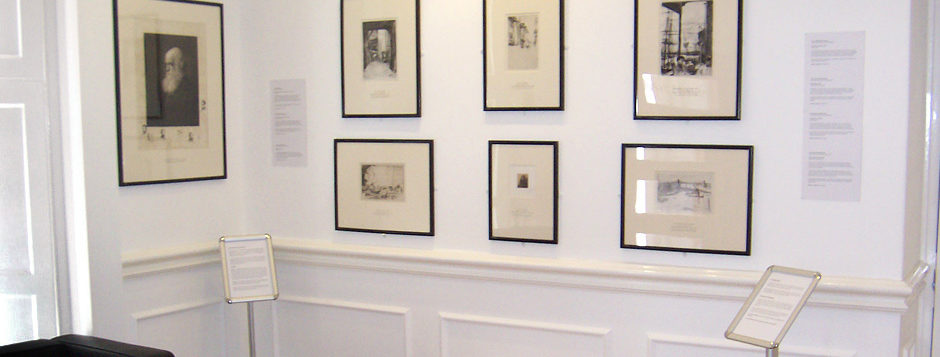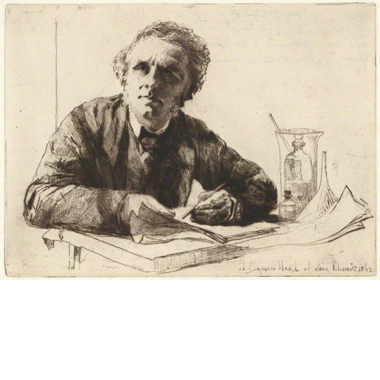
Orchar’s collection includes a number of distinctive and extremely rare impressions of the works of Sir Francis Seymour Haden. The inclusion of these works highlight Orchar’s knowledge and engagement of the printmaker’s art during an unprecedented rise of interest in producing and collecting etchings in the mid to late 19th century. This period would later be identified as ‘The Etching Revival’.
Henry Alken’s introduction to The Art and Practice of Etching (1849) noted the satisfaction gained by the printer in producing works and the joy of sharing them; ‘multiplied by thousands, to grace the portfolios, the albums and the scrapbooks of near and distant friends…’ (1). Similarly, Joseph Maberly’s The Print Collector (1844) noted
…the pleasure or utility of a collection much depends on imparting it … to duly admire and enjoy a fine picture, especially any of the Italian schools, a regular professional education is almost essential. To enjoy a gallery of painting, or statuary we must walk about it, and we must have daylight; but a portfolio of prints may be laid on the table and give variety to the amusement of a winter’s night when variety of occupation is most in requisition, and all the circle as they sit, may participate in the enjoyment. (2)
A collector’s passion for etchings was actively encouraged by a number of leading publications namely P.G. Hamerton’s art magazine The Portfolio which ran from 1870 to 1893 and his influential book Etching and Etchers from 1868. Other journals such as English Etchings (1881-1891) and The Etcher (1879-1883) furthered the taste for modern prints. Unlike paintings, which would be hung in the public spaces of a house, prints were a more private pleasure to enjoy at one’s own leisure. Crucial in influencing this trend were the achievements of two groups; The Etching Club and The Society of Painter-Etchers.
The Etching Club
The Etching Club, founded in 1838 by Charles West Cope, included a number of artists who were of interest to Orchar. Haden himself was a member from 1860 until he resigned in 1878 to form the Society of Painter-Etchers. James Clarke Hook was a member between 1850 and 1885 as was Samuel Palmer (1850-1881). Other notable artists included John Callcott Horsley (member between 1838 and 1885), William Holman Hunt (1856-1885), John Everett Millais (1856- 1885) and Orchar’s close friend John Pettie (1876-1885). Pettie was elected a member on 13th November 1876 having been proposed by Cope and seconded by Horsley. He was elected unanimously. This link to some of the major etchers of the period would have subsequently provided Orchar with an introduction to their work and the artists to his patronage (3).
Although intended to provide support and a platform for the work of printmakers The Etching Club was elitist and rather traditional in its attitude and style. Membership was limited to 12 and any new members had to be approved by the committee. The majority of their work was sold, to subscribers, through a series of publications in which all contributors received an equal share of any profits. This share system proved problematic when comparing the labour intensive work of Palmer or Hook with the freer, and swifter, approach of Haden. Preferring to work directly from nature and often completing the initial plate in a day, Haden believed that swift execution – often suggesting form by a minimum of lines – resulted in a stronger composition and he would frequently leave large areas of the plate untouched.
An example of the resistance of the more traditional Etching Club members to the new aesthetics practiced by Haden and Whistler can be seen in a letter from James Clarke Hook to Samuel Palmer in which Hook mocked the modern etcher’s tendency to
…dip a daddy long-legs into the ink, and start him on an adventure across a continent of papier verge. A glowing eulogy appears in The Times. 1st state proofs, before daddy fluttered his wings, 5 guineas! After flutter 8 guineas!!! and so on. Poor Rembrandt! (4)
So fervent was this issue that, in 1872, Haden proposed a controversial change to the share system which did not penalise those artists who practised modern etching (5). By 1878, disillusioned with the club’s resistance to aesthetic experimentation Haden eventually resigned. In the face of competition from Haden’s rival Society of Painter-Etchers, The Etching Club limped on until it was finally disbanded in 1885.
The Society of Painter-Etchers
The first organised meeting of The Society of Painter-Etchers (still in existence today under the title The Royal Society of Painter-Printmakers) took place at Haden’s home at 38 Hertford Street, Mayfair on 31 July 1880 during which six artists were elected Fellows; Heywood Hardy, Hubert von Herkomer, Alphonse Legros, Robert Walker Macbeth, James Tissot and Haden himself (6). Haden’s first proposal was to carry a resolution to promote original etching (rather than reproductive etching) and their first official exhibition took place at the Fine Art Society’s rooms in Bond Street, London in March 1882 (7). These exhibitions followed those of the Fine Art Society and Dudley Gallery’s Black and White Exhibitions in London from the early 1870s.
Haden at the Dundee Fine Art Exhibitions
It seems no accident therefore, that the majority of Haden prints shown at the Dundee Fine Art Exhibitions should be in the years 1879 to 1881 thus coinciding with the demise of The Etching Club and the foundation of Haden’s Society of Painter-Etchers. It certainly suggests Orchar was aware of the interest surrounding the society and perhaps hoped to gain some attention for the Dundee exhibitions whilst supporting the Society in its aims.
In total seventeen prints by Haden were shown over these three years and they were the only ones by the artist shown at the Dundee exhibitions between 1877 and 1895 (8). Prices of these prints were not shown in the exhibition catalogues; they included only the statement ‘price of Pictures not given in the Catalogue may be learnt from the Secretary’, and whilst it is possible Orchar owner them prior to 1879 it seems more likely he bought them during the exhibition (9). Typically, as with the inclusion of James Clarke Hook’s The Mussel Gatherers and Paul Adolphe Rajon’s Prayer, which were both shown in the 1881 exhibition, works owned by Orchar were identified as ‘Property of J.G. Orchar, Esq.’ in the catalogues. The absence of this identification with regards to the Hadens’ suggests Orchar bought them during the exhibition. Consequently, considering his extant collection includes twelve – possibly fifteen – of the seventeen exhibited, it is tempting to suggest that he owned the others too. By all accounts Orchar seems to have been the main collector of Haden’s prints in Dundee during this period and a number of impressions in the collection are extremely scarce pieces (10).
Orchar’s collection contains a number of noteworthy pieces by Haden including works from early in his career, such as Thames Fishermen, No.1 (1859) though to Greenwich (1879/80). Amongst the collection are a number of limited impressions including a view of Windmill Hill in Dorset (Windmill Hill, No. 1, 1877) of which only a handful of impressions were made of state 2.

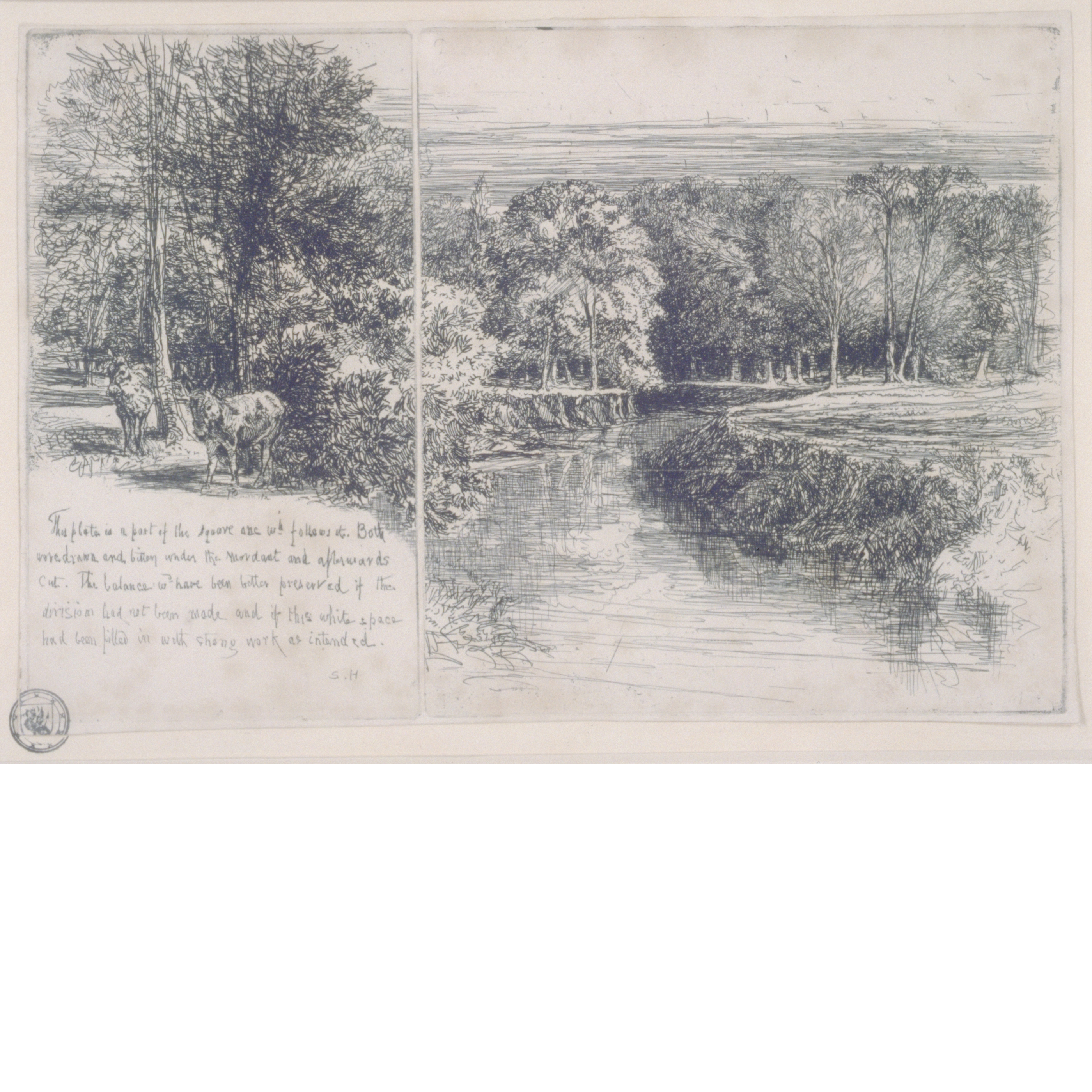
Sir Francis Seymour Haden, The Two Asses and Dundrum River. Etching & Etching with Drypoint, 15.2 x 22.9 cm. The Orchar Collection: 272-1987-108. Dundee Art Gallery and Museums.
Certainly one of the most unusual and rarest prints in the collection is The Two Asses and Dundrum River (1863) which depicts a view in Viscount Hawarden’s estate at Dundrum, County Tipperary, Ireland. Richard S. Schneiderman’s A Catalogue Raisonné of the prints of Sir Francis Seymour Haden incorrectly identifies the Orchar print to be an example of two separate prints mounted closely together and notes that there are ‘only one or two examples of the two plates being printed together on a single sheet of paper, but the example in AP [Collection of Alexis Pencovic, San Francisco, California, USA] is the only one known’ (11). The mount of the print in Orchar’s collection, added when it was framed in the 1930s by Aitken Dott and Sons, states that the print was created by printing the two plates on a single sheet of paper and a close examination of the print confirms this. Discussing the separate printing of the plates Frederick Goulding, Haden’s preferred London printer, recalled
In the December of this year [1866] I commenced the printing of two etchings by Seymour Haden which he used for illustrating an article in the Fine Arts Quarterly Review, published in 1867; and this was really the commencements of my printing his etchings. I see by my books that two thousand of each plate were printed, and wonder what became of them all. I do not think that very many were ever issued. They were printed at the Firm of Day and Son where I was still at work. The plates were really one large plate cut into two, one being titled ‘A River’s Bank,’ the other ‘The Two Donkeys.’ I never saw a proof of the uncut plate, but I have a proof of the two plates printed together, on which Haden wrote – “To F. Goulding, with thanks for excellent printing” – and I have prized this proof ever since. (12)
Whistler, Haden and the Thames

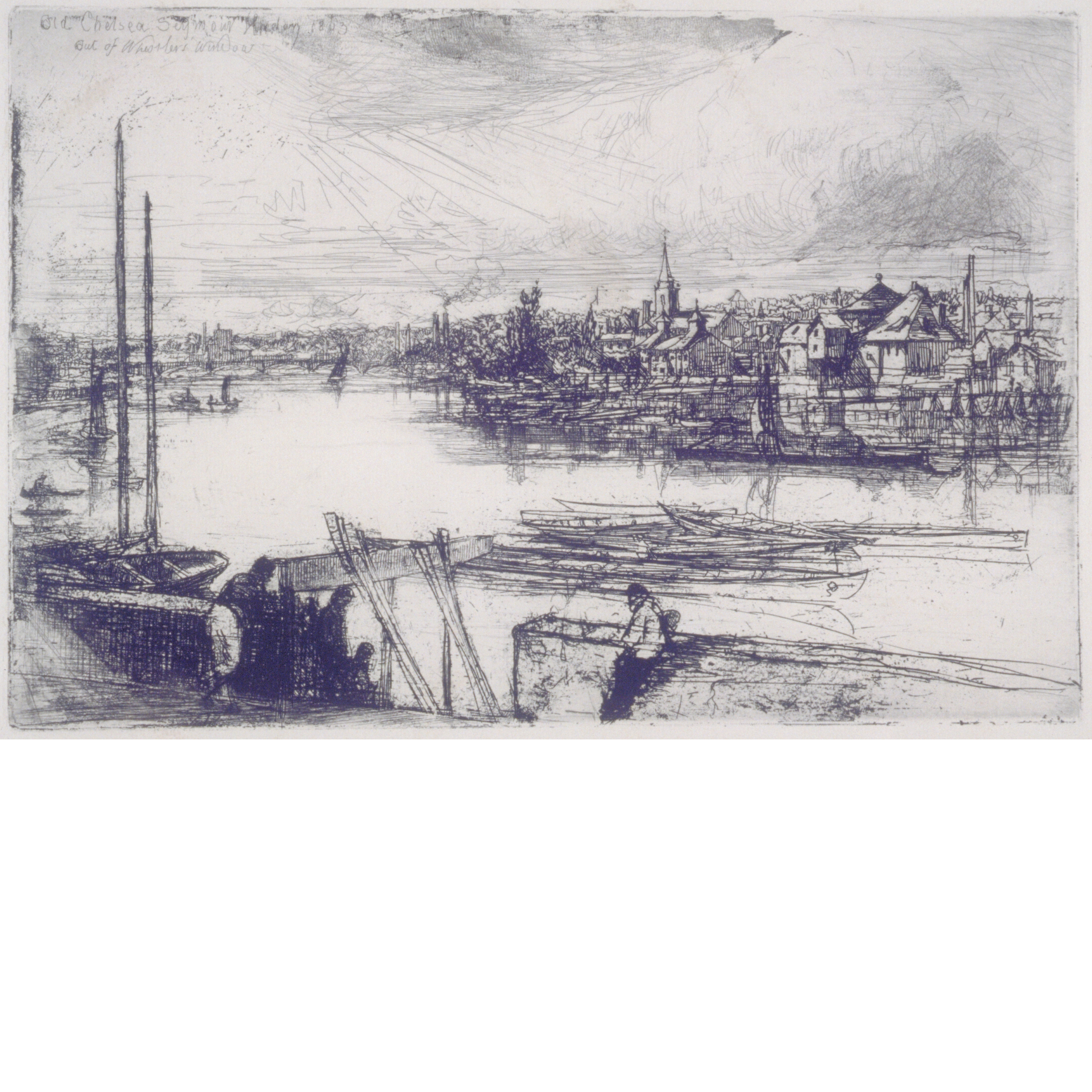
Sir Francis Seymour Haden, Battersea Reach: Out of Whistler’s Window. Etching with Drypoint, 15.2 x 22.9 cm. The Orchar Collection: 272-1987-110. Dundee Art Gallery and Museums.
Included within Orchar’s collection are a number of works Haden made of the Thames, including a very rare first impression of Yacht Tavern, Erith (1865). In later impressions Haden would add his signature along the rail of the balcony and remove the girl and most of the ships from the scene. The majority of Haden’s Thames etchings were produced between 1859 and 1865 and were partly inspired by the interest of his brother-in-law James Abbott McNeill Whistler. It certainly was the case that the two artists intended to work on a collaborative project to capture scenes of the river. On 29 June 1862 Haden wrote to his French printer Auguste Delâtre stating;
Whistler is working well. Among other things we are planning four instalments of twelve plates: each of the views made on the Thames from its source to the sea. That will make 48 plates altogether… interesting, for our river is very droll. (13)

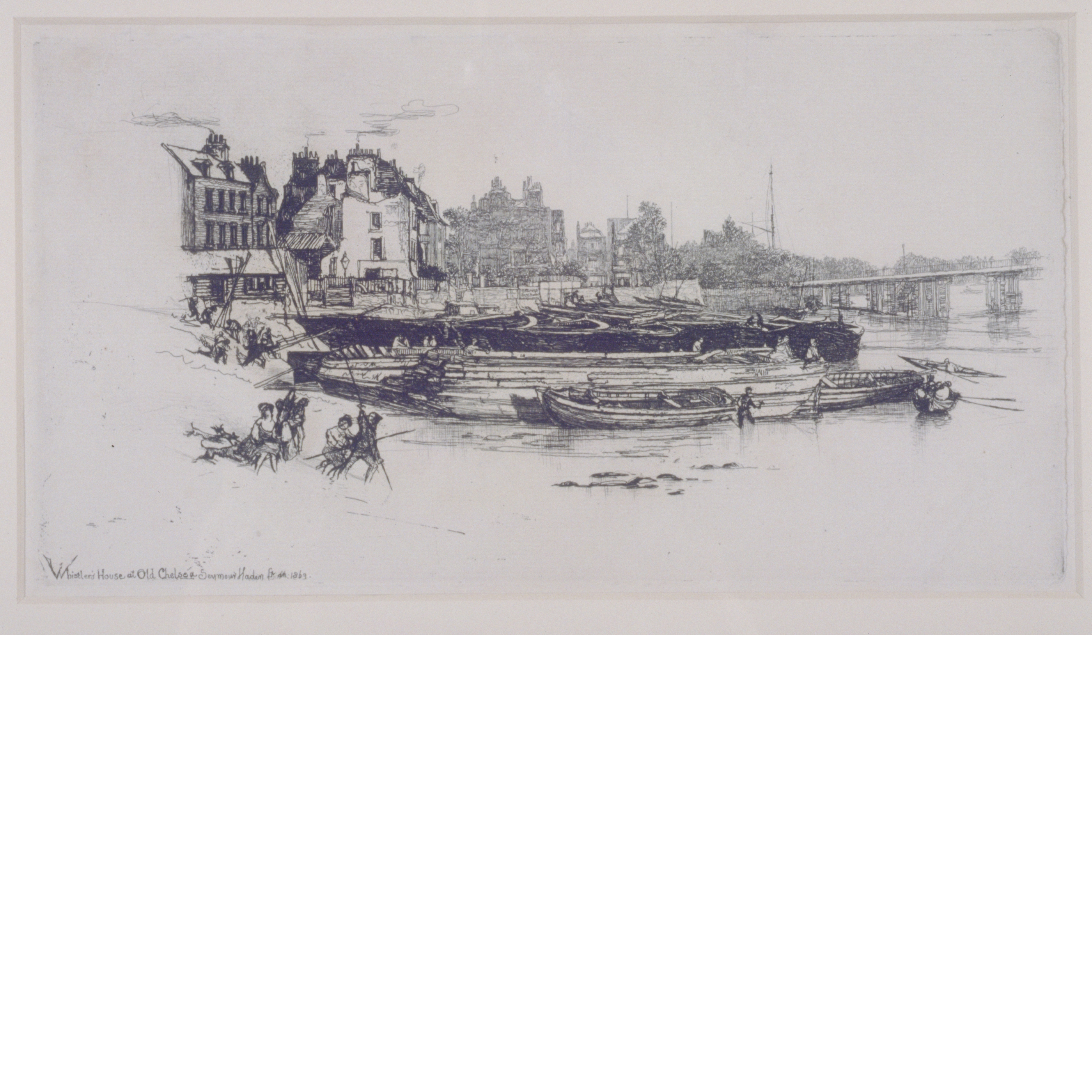
Sir Francis Seymour Haden, Whistler’s House, Old Chelsea. Etching with Drypoint, 17.8 x 33.7 cm. The Orchar Collection: 272-1987-106. Dundee Art Gallery and Museums.
The project never materialised but a number of the prints in Orchar’s collection relate to the proposed scheme including two images relating to Whistler’s house in old Chelsea; Battersea Reach: Out of Whistler’s Window (1863) and Whistler’s House, Old Chelsea (1863). Both capture an essence of the noise, energy and industry of the location and were evidently inspired by Whistler’s interest in realist scenes of urban London whilst simultaneously identifying a personal connection with a place and its people.
Orchar’s collection of Haden’s prints can therefore safely lay claim to a reputation of a significant and unique gathering of work. Not only does its range provides a valuable survey of the printer’s work in both scope and quality it also highlights Orchar as an insightful and considered collector himself.
|
